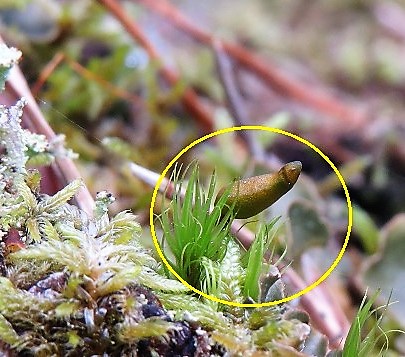16 October 2018 by Chris Cathrine | Comments: 0
Share this article:

Back in August we were lucky enough to be invited to assist with bryophyte (moss and liverwort) recording on the Woodland Trust Glen Finglas estate. The recording day was instigated and lead by Jane Jones (Botanical Society of Britain and Ireland) and Gwen Raes (Woodland Trust Estate Ranger). We were also joined by Jack Ravenscroft (Woodland Trust Ecological Research volunteer) and bryophyte expert Gordon Rothero (British Bryological Society).
Gwen skilfully drove us along the long, steep track north east of Glen Finglas reservoir to Creagan nan Sgiath and the lower slopes of Ben Vane, which would otherwise have been a 27km round trip on foot from the Glen Finglas car park! I have experienced this particular walk (otherwise known as the Mell circuit) on a previous jaunt and can vouch it is long and gruelling and would certainly leave limited opportunity to search the upper crags for bryological treasures….although I was treated to spectacular close views of a golden eagle on that occasion…swings and roundabouts!
Getting a lift to the site meant we could focus our efforts on recording our target location…the calcareous montane crags Creagan nan Sgiath, where we recorded 99 species of moss and liverwort at heights of 450m to 650m a.s.l. The most interest was present on the highest calcareous crags where nationally scarce Encalypta ciliata, Scapania cuspiduligera, Scapania degenii and Bryum dixonii were recorded. The bryophytes recorded overall are a distinctive and reasonably diverse group which are localised but fairly typical of this habitat type - upland calcareous crags. There are frequent cushions of Grimmia funalis and occasionally occurring Anoectangium aestivum, Molendoa warburgii, Ditrichum gracile, Orthothecium intricatum, Thuidium delicatulum, Mnium marginatum and Plagiobryum zieri. One species, Racomitrium elongatum, was recognised as being a first for the vice county in which the site occurs (West Perthshire). This was recorded on gravelly soil on the lower slopes.
With a little time to spare on the drive back round the Mell circuit we climbed up towards a small incised ravine on the lower slopes beneath Creag a Mhadaidh north west of Ben Vane. The greatest interest was recorded in flushes below the ravine, not least from a splendid display of dozens of peacock butterflies amongst rushes and devil’s bit scabious, but with the addition of an assemblage of base demanding species including Campylium stellatum, Scorpidium cossonii, Scorpidium revolvens, Sphagnum contortum and Sphagnum inundatum. Their presence which indicates some base rich flushing spurred us on with promise for potentially interesting species in the ravine, but alas it would only be the precipitous climb into the ravine that got my heart going!
A good day of recording thanks to the team. There is still more scope for further recording in the glen with more unexplored crags to conquer!
23 June 2017 by Chris Cathrine | Comments: 0
Share this article:

Senior ecologist and company bryologist Julie Smith reports from amongst the fallen trees of the Black Wood of Rannoch.
In January 2017 Caledonian Conservation Ltd undertook a surveillance survey across the Tay Forest District for a rare bryophyte listed under Annex II of the EU Habitats Directive which occurs on deadwood, green shield moss (Buxbaumia viridis). The aim was to survey suitable habitat to improve understanding of the distribution of the species in Scotland.
During a recent Native Woodland Discussion Group (NWDG) meeting a member had noted that there appeared to be a lack of deadwood across the Site of Special Scientific Interest (SSSI) element of Black Wood of Rannoch, one of the largest extents of ancient Caledonian Pine wood in Scotland. While our winter survey there had indeed found limited quantities there was locally frequent deadwood of good size and stage of decay along the Dall Burn and its tributaries to the east. Buxbaumia viridis was not recorded within the SSSI, but it was on neighbouring Forest Enterprise (FE) land, by the Kilvrecht campsite, again to the east.
In spite of the long term use of the Black Wood for timber extraction up until the wartime felling of the 20th century, the ancient pinewood has persisted and is now managed by Forest Enterprise (FE) under non-intervention. It is expected there will be an increase in deadwood across the SSSI in future years, which means more suitable habitat for Buxbaumia viridis. FE staff and other visitors to the woodland should be encouraged to familiarise themselves with this distinctive little moss and its preferred microhabitat, as it may very well turn up there soon!
At the end of the NWDG meeting Julie revisited the mature fallen Kilvrecht birch tree where the moss was found and became reacquainted with the impressive capsules, albeit at a different growth stage!
The photo below shows a Buxbaumia viridis capsule on mature fallen birch tree in early June 2017 (capsules have reached maturity and are golden brown in colour).
22 May 2016 by | Comments: 0
Share this article:

A Nationally Scarce moss Sphagnum austinii has been recorded on site by our in-house bryologist Julie. This species of Sphagnum moss is a first for vice county 101 Kintyre! The presence of this moss indicates a relatively undisturbed area of blanket bog.
This species can be readily identified in the field owing to the firm hummocks it can form and the ochre-brown to chestnut colour. However, identification should be confirmed at the microscope (looking for ‘comb fibrils’ in the stem leaves), as this species could be confused for other species of Sphagnum moss.